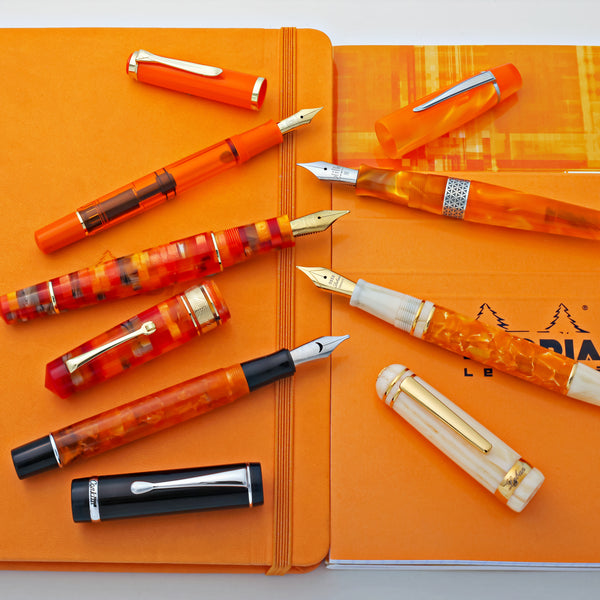Fountain pen converters are an essential tool for pen enthusiasts who wish to enhance their writing experience. This guide covers everything you need to know, including what they are, how they work, the different types available, and how to use them effectively. Whether you're new to the world of cool fountain pens or an experienced writer, this guide will deepen your understanding and appreciation of fountain pen converters.
What Are Fountain Pen Converters And How To Use Them?
What is a Fountain Pen Converter?
A fountain pen converter is a small device designed to allow fountain pens that typically use disposable ink cartridges to use bottled ink instead. One benefit of a converter is that it provides flexibility, enabling pen owners to explore various ink colors and types. The converter fits where the ink cartridge would typically go, allowing you to draw ink directly from a bottle into the pen. This mechanism offers more ink capacity, versatility, and a more personalized writing experience.
How Does a Fountain Pen Converter Work?
Fountain pen converters function by creating a vacuum or pressure system to draw ink from a bottle. Once attached to the pen, the converter’s mechanism (whether piston, squeeze, or other types) draws ink through the pen’s nib into the converter, filling it up and preparing it for writing. The process is simple but requires care to prevent spills and ensure an optimal ink flow.
Types of Fountain Pen Converters
Piston Converter
Design and Mechanism
The piston converter operates with a small piston inside the chamber. Turning the knob moves the piston, creating suction to draw ink into the converter.
Advantages and Disadvantages
Advantages: Easy to fill, consistent ink flow, holds a reasonable amount of ink.
Disadvantages: Slightly larger than other types, may not fit all pen models.
Squeeze Converter
Design and Mechanism
Squeeze converters use a simple design involving a rubber sac. When squeezed, air is expelled, and when released, ink is drawn into the sac.
Advantages and Disadvantages
Advantages: Simple and quick to use, compact.
Disadvantages: Holds less ink compared to other types, may be prone to leakage.
Push-Button Converter
Design and Mechanism
Push-button converters use a button mechanism that creates pressure to draw ink into the converter. The button action is straightforward and user-friendly.
Advantages and Disadvantages
Advantages: Quick filling process, beginner-friendly.
Disadvantages: May not fit all fountain pen models, limited ink capacity.
Aerometric Converters
Design and Mechanism
This type features a metal or plastic bar that, when pressed, compresses a rubber sac to expel air and draw ink into the converter.
Advantages and Disadvantages
Advantages: Reliable and easy to fill, typically fits a wide range of pens.
Disadvantages: Limited ink capacity, requires frequent refilling.
Disposable Ink Cartridges vs. Converters
Fountain pen users often debate between using disposable ink cartridges and converters. While cartridges are convenient and clean, converters provide the flexibility to use a wider variety of ink types and colors, making them the preferred choice for those who want to personalize their writing experience while also not contributing to single-use plastics!
Benefits of Using a Converter
✅ Cost-Effective
Using a converter allows for purchasing bottled ink, which is more economical than disposable cartridges in the long run.
✅ Eco-Friendly
Converters reduce plastic waste by eliminating the need for single-use cartridges, making them an environmentally friendly option.
✅ Customizable Ink Options
With converters, you have access to an endless variety of ink colors and properties, enhancing creativity and customization.
How to Use a Fountain Pen Converter
1️⃣ Preparing Your Fountain Pen
Before filling the converter, make sure your pen is clean and ready to use. Remove any existing cartridges and ensure the nib is properly aligned.
2️⃣ Inserting and Securing the Converter
Attach the converter securely to the pen, ensuring it is tightly fitted to avoid any leakage during the filling process.
3️⃣ Filling the Converter with Ink
Dip the nib into the ink bottle and operate the converter mechanism (twist, push, or squeeze, depending on the style of converter mentioned above) to draw ink. Ensure the nib is fully submerged to prevent air bubbles.
Which Fountain Pens Use Converters?
As a general rule, what is called a standard international converter will fit most fountain pens. But, of course, there are exceptions to every rule. Our guide to converter compatibility showcases the various options available for those looking to see if a certain pen has a proprietary converter or not.
We know that some of our customers’ favorite pens have some special converters which aren’t an international option. These include:
-
Lamy Safari: LZ28 converter
-
Kaweco Sport: Small Sport piston converter
-
Pilot Vanishing Point: CON-40 converter
Keep this in mind when purchasing your pen, so you can add to your order!
How Converters Affect Writing Smoothness and Flow
The quality of the converter and the ink used can significantly affect the writing experience. Properly filled converters ensure a smooth ink flow and consistency, enhancing the overall feel of the pen on paper. Regular cleaning and maintenance of converters help maintain this flow.
Fixing Common Converter Issues & Solutions
Is Your Converter Leaking?
Ensure all connections are secure, and the converter is correctly fitted. Replace worn-out parts if necessary. If the problem persists, consider switching to a different type of converter that may offer a better seal.
Ink Not Flowing Right?
Check for air bubbles and expel them by gently pressing the converter mechanism. Also, clean the nib and converter regularly to maintain flow. If ink still isn't flowing, make sure the nib is not clogged and that the pen is properly aligned with the converter.
Creative Uses of Fountain Pen Converters
Converters aren’t just for ink. Some enthusiasts use them for artistic projects, such as experimenting with watercolor effects or shading techniques by mixing different ink colors. This method allows you to create your own unique hues and gradients for calligraphy and sketching.
Perhaps less creative in the traditional sense, a converters can also be used to clean out your pen with pen flush or even just warm water.
Finally, many of you are sure to be familiar with the benefit of having converters around to sample inks, versus committing to buying a pack of cartridges. Filling a small amount of ink into the converter lets you test different brands or colors without committing to filling the entire pen, especially if you’re sharing a bottle among friends or at pen shows where testers are available.
How to Choose the Right Ink for Your Converter
Select ink that is compatible with fountain pens. Avoid thicker inks or those meant for other writing instruments, as they can clog or damage the converter. Always check the ink’s properties—fast-drying, waterproof, or shading inks—to see if they align with your writing or artistic needs.
Expert Tips for Maintaining Your Fountain Pen Converter
-
Regularly clean your converter by flushing it with water.
-
Use a converter-specific cleaner if necessary to remove stubborn ink residue.
-
Store pens upright to prevent leaks when not in use.
-
Lubricate the piston mechanism of the converter with a small amount of silicone grease to ensure smooth operation.
Converters FAQ
Can I Fill a Fountain Pen Converter With a Syringe?
Yes, using a syringe can be a clean and precise way to refill your converter, ensuring no air bubbles. Syringes are also helpful for transferring ink directly from bottles that may be too narrow for the nib to fit. This method is especially useful when dealing with hard-to-reach ink levels in the bottle or ink sample vial.
What is Better for Fountain Pens: Cartridge or Converter?
Why Do Fountain Pens Leak at Higher Altitudes?
How Do You Refill a Fountain Pen?
How Often Do You Need to Refill a Fountain Pen?
About the Author
Brett F. Braley-Palko works in the pen industry by day and is a novelist, consultant, and freelance writer by night. You can find his work in a variety of publications, like British GQ and Robb Report. Follow him on Instagram at @brettfbraley or visit his website at brettfbraley.com






